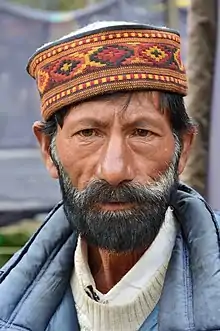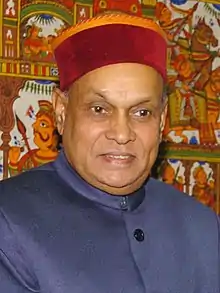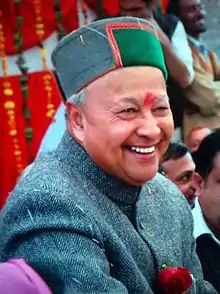Himachali cap
Himachali cap (Pahari topi, Pahari cap, Kinnauri cap) is a distinctive headdress associated with Himachal Pradesh's culture. Pahari topi or Himachali cap is a part of the traditional dress of many Pahari inhabitants.[1][2][3][4]

History
The Himachali cap was historically related to Kinnaur and reached other parts of Himachal Pradesh via princely Bushahr state and Kullu.[5][6]
Material and Shape
Himachali caps are one of the popular arts and crafts of Himachal Pradesh.The Himachali cap is usually made of wool, and the shape is typically round or boat shape. [7]
Types
There are unique colors and styles vary with the region.
Traditional wear
Cap is an ingrained part of daily wear over there, and it is common during local festivities, religious functions and marriages, etc.[8] Men in almost all hilly areas like Kangra and Hamirpur wear kurta pajamas and caps, and women wear churidar pajamas or salwar with kameez and dupatta.[7]Himachali caps are the representation of cultural identity. People in Himachal consider the cap as a pride,[9] like a turban for Sikhs in Punjab.[10]
Political identity
—Prem Kumar Dhumal tweeted for Narendra Modi when he dressed in Himachali cap with a maroon band during his visit to Israel.[11]
The colour of the Himachali caps has been an indicator of political loyalties in the hill state for a long period of time with Congress party leaders like Virbhadra Singh donning caps with green band and the rival BJP leader Prem Kumar Dhumal wearing a cap with maroon band.[12][13]
Gallery
.jpg.webp) Narendra Modi in Himachali cap
Narendra Modi in Himachali cap Prem Kumar Dhumal in Himachali cap.
Prem Kumar Dhumal in Himachali cap. Virbhadra Singh in Himachali cap.
Virbhadra Singh in Himachali cap..jpeg.webp) Himachali Caps
Himachali Caps
See also
References
- Broadcasting, India Ministry of Information and (1956). Himachal Pradesh. Tourist Division, Ministry of Transport. p. 22. ISBN 978-81-7199-465-6.
- Shaikh, Ameen (2019-04-01). ShaikhSpear in Himachal. Mountain Walker Private Limited. p. 173. ISBN 978-81-940505-0-6.
- "Himachali Cap (Topi) -Buy Kullu, Shimla, Kinnauri and Malana Cap". HimalayanKraft. Retrieved 2021-01-16.
- "The Himachali cap - Culture, legacy and heritage Issues and analysis @ abhipedia Powered by ABHIMANU IAS". abhipedia.abhimanu.com. Retrieved 2021-01-16.
- Chitkara, M. G. (1999). World Government and Thakur Sen Negi. APH Publishing. p. 25. ISBN 978-81-7648-032-1.
- Verma, Shruti (2018-02-02). "The Himachali cap: Culture, legacy and heritage". HimVani. Retrieved 2021-01-16.
- Broadcasting, India Ministry of Information and (1956). Himachal Pradesh. Tourist Division, Ministry of Transport. pp. 128, 129. ISBN 978-81-7199-465-6.
- Verma, Shruti (2018-02-02). "The Himachali cap: Culture, legacy and heritage". HimVani. Retrieved 2021-01-17.
- Wagner, Anja (2013-06-01). The Gaddi Beyond Pastoralism: Making Place in the Indian Himalayas. Berghahn Books. p. 34. ISBN 978-0-85745-930-5.
- ""Importance of turban in Sikhism" - Early Times Newspaper Jammu Kashmir". www.earlytimes.in. Retrieved 2021-01-17.
- "PM Modi's cap in Israel takes political hue in Himachal". Hindustan Times. 2017-07-06. Retrieved 2021-01-17.
- Archana Phull (14 January 2018). "Cap likely on 'cap politics' in Himachal Pradesh". The Statesman. Archived from the original on 13 March 2018. Retrieved 12 March 2018.
- Gaurav Bisht (6 July 2017). "PM Modi's cap in Israel takes political hue in Himachal". Hindustan Times. Archived from the original on 13 March 2018. Retrieved 12 March 2018.